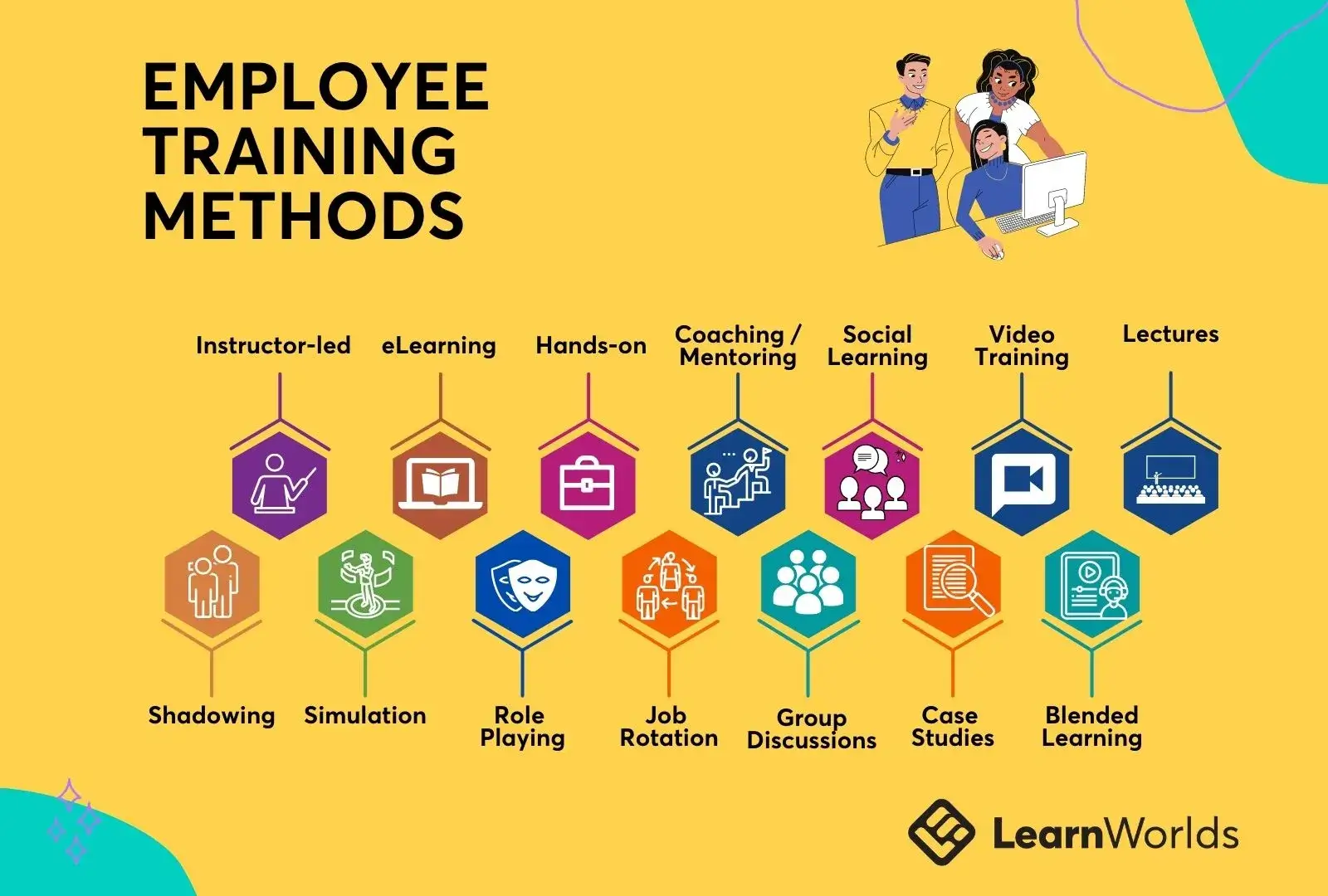Table of Contents
Employee training and development programs are incredibly important for onboarding, productivity, and retention.
A good training program can decrease costs and increase efficiency for the company, along with many more benefits. Learning and development is also a great perk for top talent looking for opportunities, growth, and career advancement.
In this article, we will explore 16 types of employee training you can use at all stages of the employment lifecycle.
Types of Employee Training & Development
There are many types of employee training, depending on the type of work, business goals, and budget. Here is the list of the most popular ways of employee training and development:

Why are employee training programs important?
Employee training and development starts at onboarding and continues throughout the whole employment lifecycle. Providing learning and development opportunities is important as it allows you to build a productive workforce and retain top talent.
Training programs can multiply the value of an employee and help at retention. Here are some key benefits of employee training and development:
In some cases, employee training may be required for compliance with industry standards or government regulations.
On the other hand, bad or excessive training may result in the opposite. Be careful when designing training programs and always get feedback from employees and management.
Choosing the Right Training Methods for Employees
Different jobs require different hard and soft skills training. Human resources need to think of the type of employee training they will choose for each role.
Effective employee training usually combines several different methods. Modern companies rely more and more on a combination of learning management systems (LMS) and on-site training to achieve the best results.
LearnWorlds has everything you need in an LMS and it can help you train your employees.
As a modern, easy-to-use LMS, you can use it to create your company’s educational portal. Upload your content, track progress, and issue certificates for your employees. Try LearnWorlds today:
Instructor-led training
Many businesses find that instructor-led training is the most effective way to meet their training needs. Seminars and workshops can easily be customized to meet the organization’s specific needs.
Instructor-led training can be cost-effective, flexible and personal. Instructors can adapt on the go, change their training over time and can be both internal or external instructors.
Instructors are required to work with human resources or managers to create a training plan suited for the business goals of the training, and can provide the training either on-site or through webinars.
eLearning
E-learning rises in popularity as online training material can be created and distributed just as easily and quickly. It is usually more expensive to create, but can be reused, and employees can access and go through the training resources at their own pace.
This is achieved with the use of a learning management system (LMS) or an elearning platform that allows you to establish your elearning system and upload work-related or training sessions to it.
From there your employees can have access to learning resources, take assessments and earn certificates on a range of subjects including compliance training and CPE. Companies can also purchase ready-made training material to add to their LMS or purchase courses to other platforms for more training.
E-learning can also include microlearning courses or activities such as flashcards, video demos, podcasts, simulators, and other microlearning activities.
Hands-on Training
On-the-job or hands-on training jumps straight to the more technical or practical skills necessary for the job. New hires begin working immediately with this training method and are able to learn the ropes while getting paid.
This allows workers to learn on the job while earning money and employers to benefit from their work immediately.
Oftentimes, this type of training is seen in fields for blue-collar workers or easy-to-learn jobs, where an employee can immediately start with a basic role and then gradually take on more responsibilities.
Hands-on training also comes with some downsides, as new hires are less experienced and may make more mistakes which are costly for the company.
Coaching or Mentoring
One way to onboard new employees effectively is to pair them with a coach or mentor. This allows the new employee to get more one-on-one attention and have all of their questions answered.
It also helps them to develop a relationship with someone at the company, which offers a smoother transition. Coaching or mentoring new employees makes the onboarding process more effective and allows employees to feel comfortable in their new roles.
While coaching is a great way to onboard new employees, it is time-consuming and requires a lot of senior staff hours.
Job Shadowing
Job shadowing has new hires observing what other colleagues or experts are doing and what methodologies they are following in order to carry out their job effectively. In this training setting, new employees need to follow and observe other experienced employees, accompanying or ‘shadowing’ them to staff meetings, their daily work and other activities.
It is especially useful for jobs like:
This type of training is widely used in internships as well, since it helps to boost career development. It helps interns gain a better understanding of how the organization functions and what it expects from them.
Simulation
Simulations are often technology-assisted safe environments that simulate the working environment through a computer, augmented or virtual reality. A virtual environment that resembles the workplace is presented, and the employee learns how to carry out the job effectively.
Simulations are usually used to teach pilots, doctors, or heavy machinery users and in some cases in military personnel training.
The main reason for using simulations is to avoid getting an employee into a risky work environment and helping them become accustomed to certain roles. It allows them to use expensive machinery or interactions that do not happen often in real-time scenarios.
Role-Playing
Another excellent type of training is role-playing. The role-playing practice requires employees to take a role to work through difficult real-life situations and learn how to manage them effectively.
For example, working through different case studies that involve conflict at work or dealing with a difficult customer, helps them become familiar with their work environment and grow professionally.
On top of that, it allows them to develop new skills such as customer service skills and increasing their communication, problem-solving and leadership ability. Most importantly, role-playing facilitates interactive training and encourages employees to get involved.
Job Rotation
An interesting training method you can use is job rotation. Job rotation offers an exciting and fun way to increase interest and motivation by moving employees to different positions, departments or geographical locations for a short period while giving them different tasks to work on.
The practice of moving employees between tasks aims to promote experience, variety and increase the multi-skilling ability, which in large comes to reinforce company training initiatives and provides an insight into the different roles your organization carries out.
As a training method, it allows employees to acquire new knowledge, improve existing skills, develop new ones and explore other perspectives.
More often than not, employee motivation and job satisfaction go hand in hand in the modern world of work.
These two crucial elements form the cornerstone of a thriving and dynamic workplace environment.
Group Discussions
Group discussions should be encouraged more because they can be a great method of training. Working as part of a team helps to promote a wealth of benefits not only for individual employees but for the entire organization.
It helps employees become more self-aware, understand and accept their mistakes and searching for new ways to improve as members of a team. But, that’s not all it can do for your business.
Here’s what organizing workplace group discussions offer:
All of these are qualities every employer needs in their team members. No wonder why teamwork is regarded as one of the most essential skills to have on your CV.
Social Learning
Social learning is all about creating a community environment where employees can communicate freely and openly. You can do this easily through social media. Whether it’s LinkedIn, Facebook or Slack, you can create a user group and invite your employees to join.
On there, you can encourage them to chip in and exchange advice and tips, ask questions or share any training resources, tools, and materials you find useful.
Video Training
Video training is a popular way to train employees, especially remote employees, who are not working at the office premises.
Videos can take the form of:
As a highly engaging tool, videos can be used for training purposes to create enriched learning training material that employees can watch at their own pace (on-demand) as many times as they want.
Video can be combined with other forms of training to achieve better results too, and can create powerful interactive learning experiences with the right LMS.
Lectures
Lectures are big presentations that are carried out most often in physical training settings or through the online means e.g. via a webinar. They are used in order to communicate large amounts of training information to a large number of employees.
These are impersonal and should be used sparingly.
Case Studies & Required Reading
Case studies are a form of required reading, showcasing real workplace issues and how to deal with them effectively. Other forms of required reading could be product specifications or other bits of information the employee needs to know in order to complete the job tasks at hand.
In modern training practices, required reading most times gets replaced by videos, as they are more engaging. However, they are more expensive and time-consuming to produce.
Blended learning
Blended workplace learning is a great way to boost the existing knowledge of employees.
Combining multiple types of training content, such as online on-demand videos, assignments, quizzes and on-the-job practice, can improve the overall performance of training.
A misconception here is that different learners learn better with different ways audio, visual, or kinesthetic. But the truth is that repetition and variety in the learning methodologies brings the best results in training.
Offering the same material in different formats and repeating it helps develop neural connections in the brain which reinforce learning. This is the reason instructional designers and professional trainers prefer blended learning approaches and consider them as the most effective.
Gamified Learning
Gamification is the process of learning that involves different game-like elements that make learning more interesting, engaging, impactful and… fun! When offering this in a corporate environment that offers flexibility, amazing things can happen.
The Elearning Industry identifies such elements which can be used as part of any training program in the following ways:

An excellent example is the gamification badges you can award your learners inside your LearnWorlds school.
Apart from delivering an interactive learning experience, gamification has the power to boost knowledge, create interest in the training material itself, improve learning memory retention and increase learners’ participation.
A Successful Training Program
By providing the proper training to your employees, you will increase performance while cutting down huge costs. Training can help you increase job satisfaction and keep top performers in your team, close any skill gaps and create a positive company culture.
Launching a successful training program requires thoughtful planning and a robust LMS to provide the training.
Check out LearnWorlds to offer the best training for your employees and don’t forget to check our top reporting features. Skills training can be easier than ever!
Further reading you might find interesting:
Kyriaki is a Content Creator for the LearnWorlds team writing about marketing and e-learning, helping course creators on their journey to create, market, and sell their online courses. Equipped with a degree in Career Guidance, she has a strong background in education management and career success. In her free time, she gets crafty and musical.
Nick Malekos is a Senior Digital Marketer in LearnWorlds. He is a results based and well-rounded Digital Marketer with years of experience in the education industry, writer and digital literacy trainer.



